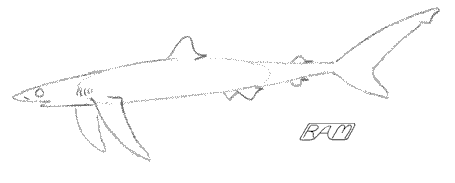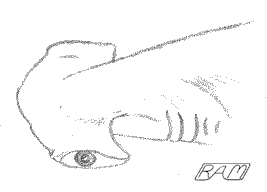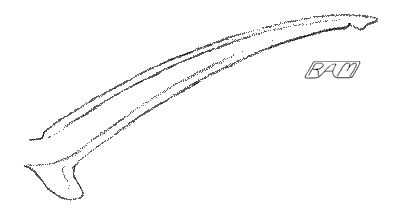Advanced Techniques -
Drawing Other Sharks
|
|

Now that you know the basic technique for drawing a Great White, try drawing other shark species. Look carefully at how each species differs from others. For example, when drawing a Blue Shark (top), start with a more elongate oval. Notice that — compared with a Great White — it's snout is longer, its eye is larger and has a white ring around it, its gill slits are smaller, its pectorals are longer and more sickle-shaped, its dorsal fin is farther back (completely behind the pectorals), its caudal (tail) fin has an upper lobe much longer than the lower, and the size and shape of the other fins are subtly different.

When drawing a hammerhead, the body is very similar to that of a 'typical' shark — only the head is radically different. Note how the cross-section of the hammer resembles a hydrofoil or wing and that the eye is on the end of the hammer. The nostrils are near the outer edges of the hammer. Look at how the hammer bows, a bit like a boomerang, and how it re-joins the body. If you can manage to draw what you see, you can create a very respectable-looking hammerhead.

When drawing a thresher shark (there are several species), the most obvious differences occur at the tail end. A thresher's caudal (tail) fin has a greatly elongated upper lobe and only a short lower lobe. Note that the tail stalk (properly termed a "caudal peduncle") is quite thick and that there is a sharp 'bump' where the upper lobe rises from the tail stalk. More subtle characteristics of threshers include a short snout, a stout, muscular body, and sickle-shaped pelvic fins. The more carefully you look for subtle differences, the more you will see.
In this way, drawing sharks teaches you not only how to identify them but also — in a much larger sense — how to look actively and interpret what you see.
|
|
